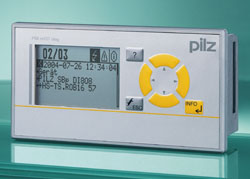
Posted to News on 4th Feb 2007, 17:13
How to use machinery safety to enhance plant availability
Products and systems for machinery safety are usually sold on the basis that they will enable customers to comply with the latest legislation, regulations and standards. However, this article explains how choosing the right machinery safety products can also enhance plant availability.

Products and systems for machinery safety are usually sold on the basis that they will enable customers to comply with the latest legislation, regulations and standards. However, there is another aspect to machinery safety that should not be forgotten: plant availability.
If production machinery stops, it impacts directly on the company's profitability. Lost production is extremely expensive, with a few minutes here and there easily adding up to hours over the life of a machine. Indeed, the value of the lost production can easily outweigh the costs of the machine components that caused the stoppages.
There is no getting away from the use of safety-related control systems on machinery, yet these are often viewed as the 'cause' of much downtime. In fact the machinery safety systems are usually only doing what they are supposed to do, preventing personnel from being exposed to hazards, and machinery from damaging itself. Nevertheless, by implementing the latest machinery safety technologies and by ensuring that the correct components are specified, machine builders, system integrators and maintenance engineers can make a significant difference to the number of stoppages and the length of time required to restart a machine.
Switch specification
Guard switches, for example, can be troublesome if specified or installed incorrectly. On guards that are frequently opened, perhaps for loading/unloading parts or for routine maintenance, the hinges can wear and the guard switch and actuator become misaligned. If a tongue-operated mechanical switch is used, it may suffer wear and premature failure. Even if a non-contact switch is used, with improved tolerance of misalignment, it may not be obvious that there is a potential problem until the switch fails to operate when the guard is closed, or maybe vibration causes the switch to break the safety circuit intermittently while the machine is running.
One way to avoid such problems is to install the switch on a robust sliding bolt, such as the PSENbolt, so that the bolt maintains the correct alignment of the safety switch on each occasion. Furthermore, if the machine guarding is subject to vibration, specifying a non-contact switch may give better reliability compared with a mechanical switch.
Terminal pros and cons
Traditional safety-related control systems use banks of safety relays wired together to produce the required logical functions. However, every wired connection can be viewed as a potential source of unreliability, and the relatively large parts count associated with a bank of safety relays inevitably has an impact on reliability. While many users in the UK still prefer screwed terminations - which are vulnerable to vibration - elsewhere there is a move towards using sprung cage clamp terminals, especially if the terminals are the plug-in type that can be quickly swapped in the event of the relay needing to be replaced. All of the latest PNOZsigma safety relays are offered with plug-in terminals with new spring-loaded terminal technology, though plug-in screw terminals are still available. When considering the pros and cons of these two alternatives, it should be remembered that spring-loaded terminals are considerably quicker to wire.
In terms of reducing downtime when a stoppage occurs, the PNOZsigma relays have a further advantage in that they have a microprocessor and six LEDs mounted on the front to deliver improved diagnostics.
Diagnostic developments
While safety relays remain appropriate for relatively simple safety-related control systems, configurable safety controllers - such as the Pilz PNOZmulti - are now widely viewed as a better option for medium-complexity projects. Because the logic connections are made in software rather than by wiring together relays, this gives a small but significant improvement in reliability. A major advantage of the PNOZmulti, however, is the improved diagnostics, particularly when used in conjunction with the PMI m107 display with PVIS intelligent diagnostics technology. In the event of a safety-related stoppage, the display presents the operator with possible root causes, enabling the troubleshooting process to be performed far more quickly. What's more, it may be that the machine operator can rectify the fault (a guard not closed, for example), without having to refer to a more highly trained maintenance engineer. Remember, the downtime saved can be worth far more than the purchase cost of a display unit.
Another option with the PNOZmulti controllers is to install a communications module to transmit diagnostic data to an HMI or machine controller. Communications modules are currently available for use with the following network protocols: Profibus, DeviceNet, CANopen, CC-Link, Interbus, Profinet/IO, EtherNet/IP or Modbus/TCP. Once again, the benefit lies in faster fault rectification and, as result, improved availability.
Most of the points outlined above will deliver small but appreciable improvements. However, the important point to note is that each of these improvements could more than pay for itself over the lifetime of the machine, making a strong case for investing a little more in up-to-date machinery safety components and systems, whether for new machines or when upgrading existing plant.
If required, Pilz engineers can work with customers to help maximise machine availability during the specification and design phases of a new project, or they can review existing machines to identify any potential problem areas and advise on upgrades to enhance availability.
For more information about engineering services visit the website at www.pilz.co.uk.
Want the latest machine building news straight to your inbox? Become a MachineBuilding member for free today >>

















